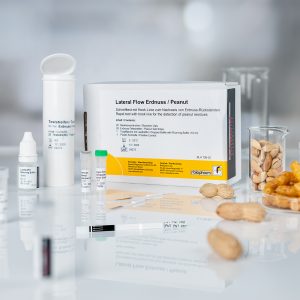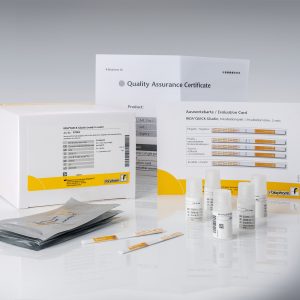Description
Intended use:
The Lateral Flow Mustard incl. Hook Line from Bioavid is an immunochromatographic test for the qualitative detection of mustard residues in environmental samples (e.g. in food production lines), CIP-water and food samples. The assay is applied for the detection of small amounts of mustard contaminations.
***NEW***
Unfortunately, very high amounts of an analyte in the sample can lead to falsely lowered or negative results – called the hook effect. The new dip-sticks will include an additional line, the hook line, in order to detect this effect. For now, the new test (BLH703-20 Lateral Flow Mustard incl. Hook Line) will not replace the old one without a hook line (BL603-10 / BL603-25 Lateral Flow Mustard), but it is an additional product offer with new functionality.
General Information:
People allergic to mustard will react to any ingredient of black, Indian brown or yellow / white mustard. Mustard consist of oil, glycoside and more than 20 % protein, some of which has an allergenic effect. Even small traces of allergens in a food can cause allergic reactions in sensitive people. Mustard is used as a condiment in meat, to prepare pastes or as an ingredient for a large variety of sauces, soups, sausages, salad dressings and marinades. Thus, it is frequently encountered in food as a hidden allergen. Food manufacturers have to check for cross contamination. Considerable deficiencies in the labelling and quality assurance of allergens can be observed, particularly for mustard. Many products, which are supposed to be mustard free, are already contaminated on the field or during processing. Cross contamination of spices with the allergen likely occurred during processing (dust formation, during crushing) or packaging. In bread available in bakeries, a mustard contamination is often observed.
The allergen can be present as an ingredient or as a contamination in raw and cooked products. According to the regulation (EU) No. 1169/2011, mustard and products thereof must be declared on food labels.
Benefits:
- Extended functionality: included hook line for safe identification of high positive samples (> 1,000 ppm).
- More precise statement in a bigger range than conventional test strips (valid results in the range of 1 – 1,000 ppm).
- A fast, reliable and easy-to-use dip stick system detecting mustard in production lines, raw materials and processed food (results in 10 min).
- More information and benefits can be found on this flyer.
Accessories:
- bioavid Swabbing Kit (plastic)
- bioavid Swabbing Kit (wood)
- bioavid Absorbent Buffer
- bioavid Sample Buffer
| Article Numbers | BLH703-20 |
|---|---|
| Test format | 20 x test strips for 20 determinations |
| Sample preparation | – Swabbing method: cleaning surface with pre-treated swab, wash out the swab and measure. – Food assay: homogenise food sample, filter, measure. – Liquid samples: no preparation. |
| Incubation time | 5 min Room temperature |
| LOD (Detection limit) | – Food samples: 1 ppm – Swabbing: 5 µg – CIP-water: 1 µg / ml |
| Cross reactivity | 7 matrices tested without cross reactivity.
Tested matrices with cross reactivity: – Rucola: < 0.1 % – Rape seed: 100 % |
| Detected analyte | Mustard residues |
| Evaluation | Visual evaluation |
| External link I URL | Bioavid Homepage – Documents for Mustard |
| Links | SOP Verification for new/unknown solid samples |
|---|---|
| MSDS |




